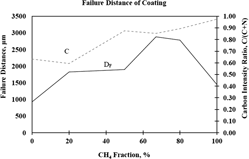Article contents
Effect of carbon content in TiCxN1−x coating on the adhesivity of carbide cutting tools and machining performance
Published online by Cambridge University Press: 03 February 2016
Abstract

Titanium carbonitride (TiCN) is a popular hard coating for carbide cutting tools in various applications. This paper studied the influence of the carbon content and coating composition within TiCxN1−x coatings with regard to their adhesive strength on tungsten carbide substrate and subsequently, the performance of cutting tool in the dry turning of stainless steel. Among all the TiCxN1−x coatings, the TiCN coating has exhibited the highest adhesivity onto a substrate, followed by a TiC coating and lastly, a TiN coating. It was found that the adhesive strength of TiCN coating increased with the carbon content. The C/N ratio or C–N bond is a vital contributor to the adhesivity of the TiCxN1−x coating rather than the C or N atoms in the TiCxN1−x coating. It was found that the coating was delaminated before the exposure of substrate material. Hence, coating with higher adhesivity will promote longer tool life.
- Type
- Invited Articles
- Information
- Journal of Materials Research , Volume 31 , Issue 13: Focus Issue: Advances and Challenges in Carbon-based Tribomaterials , 14 July 2016 , pp. 1880 - 1884
- Copyright
- Copyright © Materials Research Society 2016
References
REFERENCES
- 3
- Cited by





